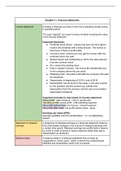Summary
Summary Managerial Finance 2 | HVA | IB | Second year
- Course
- Institution
This summary is CONCISE and PERFECT for a quick review. If you do the practice questions suggested by the professors 2-3 weeks before the exam and understand this summary it will be easier for you to pass the exam! I achieved a 8,7/10 for the exam! This concise summary include the following c...
[Show more]



